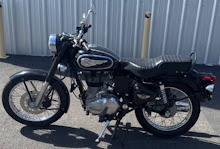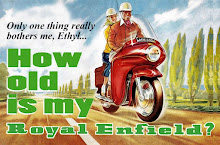 |
| Royal Enfield workers with Redditch factory exhibit at 1948 British Industries Fair. (Photo from Gordon May, Royal Enfield Books) |
Many of the passages cut from Anne Bradford's history of Royal Enfield in Britain were no doubt left out so other bits could make into her 166-page book, "Royal Enfield, The Story of the Company and the People Who Made It Great: 1851-1969."
Her book is mainly composed of the recollections of the factory workers and executives employed at Royal Enfield in those days.
Naturally, some of the memories she gathered were of more personal than historical interest. Even so, we can be grateful that the author left a full archival record of the interviews she collected.
In this and my previous two blog items, I describe a few of the omitted passages I think broaden our understanding of the time and place in which Royal Enfield was born and grew in Britain.
In one passage, employee John F. Smith (1936-1950) talked of chief planning engineer Jack Hassall, who he credited with building up Royal Enfield from the 1920s until dying only six months after leaving the firm.
Smith reports that one manager said Hassall "had died of a broken heart" after leaving Royal Enfield.
Left out of the book is Smith's note that Hassall's one bad habit had been heavy smoking: "Whenever you went into his office it would be filled with smoke and I often had to wait until he finished coughing to resume a conversation."
Roger Boss (1950-1967) would ultimately take over all UK sales for Royal Enfield, but he began as a motorcycle tester and only later went into sales with no experience.
The book omits his initial trepidations at taking over a sales territory in Wales from a Welsh speaking Welshman of 30 years experience. It turned out to be a happy career of making many friends with his wide (I had the pleasure to meet him once) smile.
Also omitted from the book is his effort to answer why the British Motorcycle Industry collapsed in the face of Japanese competition. It is, of course, an old story, but Roger's analysis goes deeper than, simply, young people liked Hondas.
To paraphrase: The Japanese started from a clean sheet of paper. With adequate financing they could assess what the world wanted, and how much the world wanted to pay for it. They carefully developed the products to match and, then, produced them in such huge quantities that their costs were reduced.
In contrast, Royal Enfield was taken over by a company that only meant to milk it. Roger saw the end coming; but that is in the book. (You have to read the book to learn the full story of Royal Enfield; don't settle for my few excerpts.)
Brian Crow (1957-1966) joined Royal Enfield at 18 years of age and "very keen." Incredibly, he immediately became part of the tiny Experimental Department, testing prototypes.
Helmets were not provided but they would not have worn them anyway, he tells us. Flat caps and goggles and wellingtons would do.
Made the young foreman of the department, Crow had the help only of apprentices, some of whom were a real handful. Not in the book is his tale of having tamed one "miserable, unhelpful, sadistic" apprentice by sending him out in the winter cold on a motor bike and threatening to do so again the next day if necessary.
Also not in the book is Crow's brief description of being the first-stage rider in the famed Land's End to John O' Groats run put on to promote the then new Continental GT 250.
In the dark, in a blizzard, and nearly lost, he made his scheduled four-hour ride with 19 minutes to spare. "But I don't know how I did it."
Charlie Blundell (1946-1951) discovered in his first month in the Test Shop at Royal Enfield that he had to be very careful what he said -- "because everybody was related."
Omitted from the book is what happened when a customer brought the brand new twin he'd bought back to the factory because of a backfire. The bike was referred to Blundell, who found a minor fault, fixed it, and offered to take the fellow for a ride to prove it. This was done, at 90 mph, to the passenger's dismay. For Blundell that was nothing; he was doing 90 mph on the bikes nearly every day.
Also omitted from his contribution is a lengthy reminiscence of Testing Department hi-jinks and accidents, many serious and one, sadly, fatal. These were too long for the book, apparently, and are too long to summarize here.
One funny story bears telling: a traffic court a judge refused to believe Blundell -- as a motorcycle tester -- hadn't been speeding, as accused. Of course, this would have to be the time he was innocent!
M.J. "Curley" Rogers (1948-1959) was assigned to test motorcycles at 16, without having passed his driving test. That's remarkable, but the book leaves out something else remarkable: he later became a dealer!
He would leave Royal Enfield to open his M.J. Rogers Motorcycles in Redditch. Even though Royal Enfields were good sellers, he ranked them below BSA, Triumph, and Norton. But "all British bikes tended to leak oil."
Nigel Buckingham (1957-1962), motorcycle tester, began his contribution with his story of being chased (allegedly at 90 mph) by a police car with its bell ringing. He claims he thought it just happened to be going in the same direction and wanted to pass. "I never dreamed he wanted me to stop."
The story got into the newspaper and Royal Enfield sacked him. He found another job, at twice the pay, but in a way he regretted it. He had lived for the riding. For example, he and his buddies had enjoyed racing the little 125 two-strokes around the test track, trying to catch up with their own smoke.
John Hill (from 1961) remembered his department using its grinder to sharpen lawnmower blades for employees. Not everyone rated this benefit: "It depended upon their status or whether or not they had a friend in the Tool Room."
David Wilson (1954-1965) and his wife were proud of their family connections to Royal Enfield, not all cheerful. "My great grandfather's brother was Tom Morris who was killed by a grindstone at the Hunt End factory."
Lenny Rudge (1957-1960) told many outrageous stories of high spirits among the young employees, not all of which made the book. "One Christmas, I was dared to ride up the long flight of wooden steps in front of our grand offices and into the front office." He did, to screams from the girls. And then he rode back down.
"Management turned a blind eye."
Peter Normandale (1953-1958) wrote that the highlight of the year was the Annual Office Girls' and Apprentices' outing to Blackpool. Not everyone got to go; you had to be "in" with the girls in the Wages Office, who organized it.
"We were all paired up, two girls with two lads, and the funny thing was we used to stay that way and we never used to split up... A lot of marriages came about after the Blackpool weekend."
He married one of the office girls from Royal Enfield, but lost her to cancer when she was only 20.
Mervyn Panting (1955-1962) remembered the degree of pilfering. The factory repaired workers' bicycles and he remembered how one employee rode in on a rusty old ladies bike, paid for a paint job, and rode out on a brand new Royal Enfield Bermuda.
Panting has one exciting story after another, including falling into the path of a lorry whose wheels passed either side of him as he lay in the road.
He, too, called the Apprentices' and Office Girls' Blackpool trip "the highlight of the year." The seat next to him on the bus was empty, so Hilary sat next to him, and they had a good time. His first day back at work he found her standing outside the factory gates waiting for him to give her a ride home. They married.
Hilary (1947-1961) remembered how she took a fall, going from the Wages Department on the third floor to the showroom on the ground floor, using a circular iron staircase, like one in a lighthouse. At the other end of the office building was a "splendid staircase" leading up to the executive offices.
Her other memories of Royal Enfield (and Blackpool trips) were much more positive.
Derek Newman (1950-1960) played an important role hosting the young man from Madras sent to Britain to study the making of the Bullet. He was chosen for this because they were about the same age. Derek's girlfriend and future wife Eileen (1953-1962), only 18, made it a threesome. "Royal Enfield was a very friendly, caring company," she wrote.
Raymond Jones (1951-1966) was grateful that his "Uncle" (actually second cousin) Oliver Wythes, the Royal Enfield works manager, found him a job, at 15, at Royal Enfield. But his desperate need for help didn't make the book. He and his sister had been orphaned young, eventually ending up living unhappily with relatives.
His sister ran away.
But, at Royal Enfield, Jones became a proficient mechanic and even suggested improvements in the motorcycles.
Jim Freeman (1948-1966) rose to head the Royal Enfield Fire Brigade, and fondly remembered the annual fire brigade championship contest with other big firms, hosted by Royal Enfield one year.
But he also remembered dark days. His job at the factory included compiling lists of materials needed for coming production. But suddenly that stopped. He kept asking how Royal Enfield was going to survive, and was told not to worry.
Next thing he knew they all had their layoff notices. He felt it was a raw deal, and for a few years he never wanted to hear "Royal Enfield" again.
Paul Savage (1954-1956) on the other hand, "was never very happy at Royal Enfield." He wasn't paid enough, and he was assigned to bicycle production even though he was mad about motor bikes.
A Mrs. Hodgetts had reason to be grateful to Royal Enfield, because it paid her father's wages during his lengthy recovery from an accident in the Royal Enfield van.
She was five at that time, but later worked for Royal Enfield herself, in the canteen, and she describes the service: sandwiches from 9 a.m. to 5 p.m., lunches 10:30 a.m. to 1 p.m. and dinner from 1 p.m. to 2 p.m. One side of the cafeteria was separated by glass. There foremen and office staff had waitress service, although the food was the same and they sat at the same style tables.
Jean Wormington (1947-1958) remembered being chosen for the Redditch Carnival Queen court. This was not a bathing suit competition. During the carnival dance, women in evening gowns were chosen from the dance floor.
Barbara Seviour (1940-1946), from the office, was also chosen for the court. Barbara was asked twice to pose on a motorcycle for a Royal Enfield advertisement, but is quoted in the book as saying that this had nothing to do with her looks. (Possibly it did?)
Diane Long was another office girl. She was taking an armful of letters across the snow to different departments when they were blown from her arms by a gust of wind. The letters had been opened and the fountain pen ink got wet and began to run. Fortunately, the dreaded Post Room supervisor never learned of this.
John Jones (1946-1956) was very happy to be assigned to repair and overhaul of the Flying Flea motorcycles. But he saw "the other side of the coin" when he left to work for Royal Enfield dealer Wilf Green. The 125cc two-stroke Royal Enfields, descended from the Flea, sold well "but we had a lot of trouble with them."
Colin Wheeler told how his father was the first person at Royal Enfield to arrive at work on a Honda two-stroke. This caused an uproar, and Royal Enfield executive Major Smith borrowed it for a couple days to try it out. On returning it he said "it's alright, but if people want quality they'll buy one of ours."
Possibly the saddest entry in the book comes from American Dean Murrah, who never worked for Royal Enfield, never owned a Royal Enfield, and hadn't visited England. He worked for Los Angeles importer Frank H. Cooper.
"We never realized the whole British industry was headed down the tubes!" he told Anne Bradford.
There were warning signs. Left out of the book was his recollection of clearing up back-orders for parts by uncrating and dismantling 700cc Royal Enfield twins. "Wonder what became of all those frames left over from this?"
With the help of Royal Enfield's Major Mountford, he gradually built up a good supply of parts.
"It was a sad day when we got the telegram telling us of Major Mountford's sudden death."
Despite Mountford's help, the knowledge and experience the Americans acquired didn't often make it into Royal Enfields. The hot-rod modifications that made the motors stronger and oil tight were judged too expensive, or were just ignored by the factory.
The Interceptor was the big seller for Royal Enfield in the U.S., but Murrah was interested to see other Royal Enfield models that were sent over in small numbers to test the market (none ever caught on).
There was the Super 5, the trials 250, the 350cc New Bullet with its unit engine/gearbox, and one lonely blue Airflow Super Meteor. He took off the unloved fairing and they sold the Super Meteor naked.
The unused fairing was still there when he left Cooper. It wasn't the only thing he wished he'd kept. He actually enjoyed putting miles on a Turbo Twin, and wished he had bought it.
Eddie Wright remembered being "very suspicious" when told at a planning meeting in the 1950s that the Japanese would be no threat to Royal Enfield. The same thing had been said about the Italian scooters that had wiped out the lower end of the market for two-wheelers.
Phylis Gibbs remembers that the factory was "overrun with cats." Major Smith was very fond of his cats and he wouldn't have anything done about them.
Sally Hawthorne (1963-1966) noticed the advanced age of many employees. "In the office was a great big ledger showing the name and address of every employee and when they started. I often wondered what happened to it."
Rita Nati (1951 to closure) gets almost the last word, in the book, and in the archives of complete interviews.
Her final words, that she would work for Royal Enfield without wages, if it ever came back, is in the book.
But left out were her appreciative words for Bob Cassey, whose job was closing up the factory and seeing its machines auctioned off: "Kind and gentle."
On learning of a worker who was upset, he would tell her to "bring them in for a chat and get them a drink, and would you like a cup of coffee?"
The real final word belongs to Bob Humphries (1950-1964) who demonstrates in a long passage how Royal Enfield excelled and had the ability to succeed and continue if only it had been given the chance.
Every word of his interview is in the book. It makes fascinating reading. Don't miss it. Buy the book.
The archive of material omitted from the book concludes with unorganized "Anecdotes and Other Information" including personnel lists for some departments, and an unlabeled site plan of the Redditch factory (there is a better version, with labels, in the book).
There is one humorous anecdote, attributed to "Anonymous" that bears description:
The many veteran military officers who became executives at Royal Enfield "often used to parade in full regalia." You'd hear the tramp of their boots, the door would fly open, and you'd hear the name of the person they wanted to see shouted, as if the place was a parade ground.
It was, after all, "Royal Enfield."





























No comments:
Post a Comment